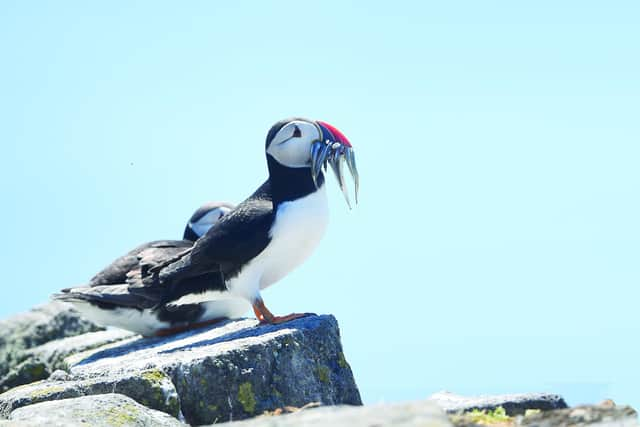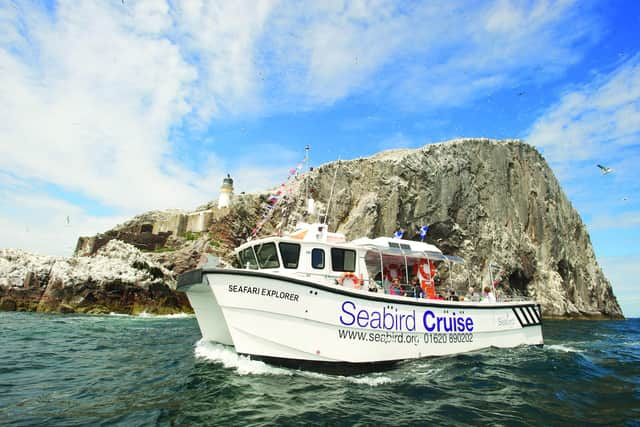Spring Travel: lovably charismatic puffins return to Scotland's shores
Puffins, with their clown-like markings and tenacious natures, are charismatic little birds and much loved.
In the UK, the population numbers around 580,000, but puffins are listed red for their conservation status and if you want to catch sight of these iconic seabirds, you have to go to the right places.
Advertisement
Hide AdAdvertisement
Hide AdEmily Burton, conservation officer at the Scottish Seabird Centre in North Berwick, says the seasonal home of the East Coast population is centred around the Firth of Forth, with birds nesting on the Isle of May, Craigleith, and Fidra.


She says: “We also get the odd pair who will try to nest on Bass Rock, but of course that is home to the gannets, so there is not too much space for puffins.”
Around Scotland there are also breeding colonies on Orkney and Shetland, Handa, St Kilda, the Shiant Islands off the coast of Lewis, and Fowlsheugh nature reserve near Stonehaven. Emily says: “Puffins nest in burrows underground because it is a very safe place for their chicks to grow until they are ready to fledge the nest.
“Sometimes they will use an empty rabbit warren, but mostly they dig their own burrows using their beaks and their feet. And in spring they will have a clear out, scraping any debris out to tidy it for the new chick.
“They will come back to the same colony year after year, because they are creatures of habit and will even try to use the same burrow.”


The first few arrive back on our shores in late March and by April they will have started their nesting behaviour in earnest, staying until late July.
They are extremely hardy little birds. Emily explains: “The rest of the year, the East Coast population will head out to the North Sea, or sometimes the Eastern Atlantic, and will spend the whole winter right out at sea.
“They are true seabirds, they don’t migrate to other countries, they spend their time in the open water, gathering together with other birds, which is called rafting, and feeding from there. They are following the food source, but it does mean having to put up with quite harsh conditions in the middle of winter.”
Advertisement
Hide AdAdvertisement
Hide AdBut spring brings with it the urge to mate, and puffins maintain relationships to get the job done. According to Emily: “They are monogamous – apart from the odd Lothario who bucks the trend – so they tend to pair for life, but will find a new mate if one of the pair dies.”
Adults incubate eggs for about 40 days and then the chick takes between 34 and 44 days to fledge, so when parents are coming in and out of their burrows to feed them is the best time to spot one.
You are unlikely to see pufflings, as their chicks are called, however. Occasionally you might see one poking out of a burrow, but they are much safer staying underground. But the adults will rest on rocks between fishing trips so there’s the chance to spot them having a breather.
Emily says: “Different seabirds feed in different ways. Some, like gannets will circle high in the sky before diving to catch a fish. Others, such as terns or gulls, will pick food off the surface of the water.
“But puffins dive from the surface of the water and use their wings to swim, up to 60 metres down, and they can stay under for quite a long time.”
Sand eels are a key source of food, but they will eat sprats, capelin, and herring, depending on their availability.
Puffins are adapted to catch and keep them in their beaks – which is why you see iconic pictures of them with a huge mouthful of masses of fish, such as the one reproduced here.
Emily explains: “They have barbs on their beaks which face backwards to secure a caught fish when they catch the next, so it is a really good technique they have going to catch the maximum.”
Advertisement
Hide AdAdvertisement
Hide AdThe pufflings fledge at night, undercover of darkness, to stay out of the sightline of predators such as the bigger gulls, skuas on the north coast, or any manner of species that might be interested in ingesting a puffin fledgeling.
Emily says: “As with a lot of seabirds, for the pufflings it will be quite an intense introduction to the world. The first time they leave their burrows they will be on their own, in open water, and the aim will be to get away as fast as possible.”
Parental responsibility ends at that point, so the wee ones need to learn to feed themselves immediately.
However, puffin populations face wider threats. Emily points to several factors: “Mammalian predators arriving on a seabird island, such as rats or mink, can have a devastating effect. They are really susceptible to human threat too, whether that is pollution, by-catch – where they are caught in fishing equipment – and there are problems linked to unsustainable fishing. So it isn’t just one threat to puffins, they are dealing with quite a few at the moment.
For the continuing safety of the birds she advises: “Wherever you go to see puffins, follow the instructions on staying a safe distance in that habitat. They are one of these seabirds that in some places allow you to get pretty close as they aren’t easily spooked but we’d always tell people to stay on marked paths, be calm and quiet, and never attempt to touch a wild animal. We want to avoid any disturbance as much as possible.
“They bring people a lot of joy. But they are also important as a hook that brings people in – we can use that as an opportunity to talk to people about all sorts of species and habitats, and the threats they are facing.”
Push the boat out
The Scottish Seabird Centre offers boat trips to the breeding colonies from its base in North Berwick, East Lothian, including landing trips to the Isle of May, and excursions that take in the puffin strongholds of Craigleith, and Fidra.
These tours present a great opportunity to experience puffins up close, and learn more about the species as you observe the endearing birds from the boat, bobbing about on the water, diving for fish, and swooping up in the air.
Advertisement
Hide AdAdvertisement
Hide AdHowever, adequate precautions need to be taken – it is the North Sea, after all. The Scottish Seabird Centre advises: “Please make sure you wear, warm water proof clothes, even on sunny days, it can be cold out on the water.”
These wildlife boat trips run from late this month to early October, and more information about times and how to book can be found at www.seabird.org/boats.